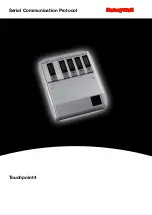
Comprehensive Operating Manual & Guide to Metal Detecting
Comprehensive Operating Manual & Guide to Metal Detecting
14
35
F75
SE
F75
SE
Ground Balancing
What is Ground Balancing?
All soils contain minerals. Signals from ground minerals are often tens or hundreds of times
as strong as the signal from a buried metal object. The magnetism of iron minerals, found in
nearly all soils, causes one type of interfering signal. Dissolved mineral salts, found in some
soils, are electrically conductive, causing another type of interfering signal.
Ground Balancing is the process by which the metal detector cancels the unwanted ground
signals while leaving signals from buried metal objects intact. This is accomplished by
establishing the detector’s internal Ground Balance setting; this setting is calibrated to the soil
and eliminates the signal produced by ground minerals.
Calibration to the actual soil condition will result in deeper target detection and quieter operation.
This calibration, or Ground Balancing, can be accomplished automatically with the detector’s
internal computer, by pushing the Trigger Switch forward, or manually in the All Metal menu.
The ground balance setting carries through into all operating modes. In
Discrimination Mode, the ground signal is generally inaudible unless
the discrimination setting is 0.
AUTOMATIC GROUND BALANCING PROCEDURE (FASTGRAB™)
1. Find a spot of ground where there is no metal present.
2. Hold the detector with the searchcoil about one foot
above the ground.
3. Push the TRIGGER SWITCH forward with your index finger.
4. Physically pump the searchcoil and detector up and
down over the ground.
Lift it about 6 inches above the ground and lower it to within 1
inch of the ground, about once or twice a second.
5. A 2-digit value will appear on the display. This is the
Ground Balance setting.
If the detector’s internal computer is unable to
ground balance, an error message will appear:
• If the message OVERLOAD RAISE COIL –
CAN’T GB appears, you will also hear a siren sound.
You are probably over metal.
• If the message CAN’T GB appears, you may not be
pumping the coil, or you may be over a small piece
of metal.
MANUAL GROUND BALANCING
In most situations, it is preferable to push the
trigger switch to activate FASTGRAB™
automatic ground balancing. Generally,
it is best to first let the computer
automatically cancel interference from
ground minerals. However, for gold
prospecting, searching on a wet
saltwater beach, or searching in an area with
so much metal trash that there is no clean
ground for the computer to sample, we recommended that you manually ground balance.
Manual ground balancing requires a bit of skill, acquired with some practice.
Note:
FASTGRAB™
will not automatically
balance over highly
conductive soils, such as
a wet saltwater beach.
Search Techniques (continued)
Estimating Target-ID
With a single sweep over a target, you will usually see a 2-digit Target-ID displayed on the LCD.
Repeated sweeps back and forth over the target may cause the 2-digit Target-ID values to change
with each sweep of the coil; this may seem inconsistent with your discrimination setting. These
variations and inconsistencies provide important clues regarding the identity of the buried object.
Most metal detectors have difficulty properly identifying steel bottle caps, and the F75 is no
exception. Steel bottle caps will often read in the coin range, at the high end of the scale.
The ID number you receive from a buried coin will usually be consistent regardless of sweep
speed or angle. The readings from a steel bottle cap will tend to bounce around a lot more,
especially with variations in sweep speed or angle. By paying attention and taking this into
account, you can minimize the number of bottle caps you dig.
The information provided by the Visual Target-ID may be different than the detector’s Audio
Feedback because the visual and audio systems are independent of one another. The internal
signals and algorithms controlling the Visual and Audio output are different. Therefore what
you hear, or do not hear, provides additional information regarding Target-ID. For instance, if
discrimination is set at 12, and most sweeps result in no visual Target-ID, the target is most likely
iron even though the majority of the ID numbers will be greater than 12.
The F75 has a tendency to up-average nonferrous targets in the proximity of iron, indicating ID
numbers higher than would be obtained in an air test. This tendency is connected with the
F75’s enhanced see-through ability – that is, the ability to find valuable targets in an area
where there is a lot of iron trash.
False Signals and Chatter
At times the detector may beep when there is nothing there, or it may seem like there is
nothing there. There are five major causes for this: electrical interference, nuisance buried
objects, ground minerals, hot rocks, and sensitivity set so high that internal circuit noise is
audible. The problem can usually be corrected by reducing the sensitivity setting, but
sometimes other measures can also be taken.
ELECTRICAL INTERFERENCE
Electrical Interference can be caused by power lines, appliances, computer equipment, cell phones,
fluorescent and vapor type lamps, household light dimmers, other nearby metal detectors, electric
fences, radio transmitters, and electrical storms. If you get abnormal noise while holding the
searchcoil motionless in the air, the cause is either electrical interference or internal circuit noise. If
it is electrical interference, by walking around with the metal detector, you can often follow the
signal and track it back to the offending device; simply turn the device off, or come back at another
time when it may be off. If the interference is from power lines, you might try another time of day.
Interference on power lines is usually caused by something connected to them which may be idle
in the evenings or on weekends. If the interference is from a communications or broadcast
transmitting antenna, reducing the sensitivity is usually your only recourse.
The F75 allows you to shift operating frequencies to avoid electrical interference. See the
Frequency Shifting section for information about this technique.
F75ltdBLK-MANUAL.qx6_M75MBLK-Manual 10/7/14 4:28 PM Page 14















































